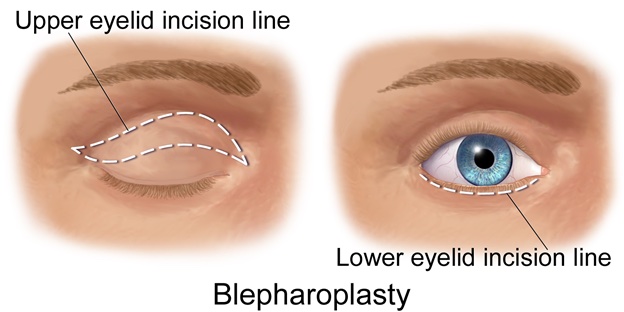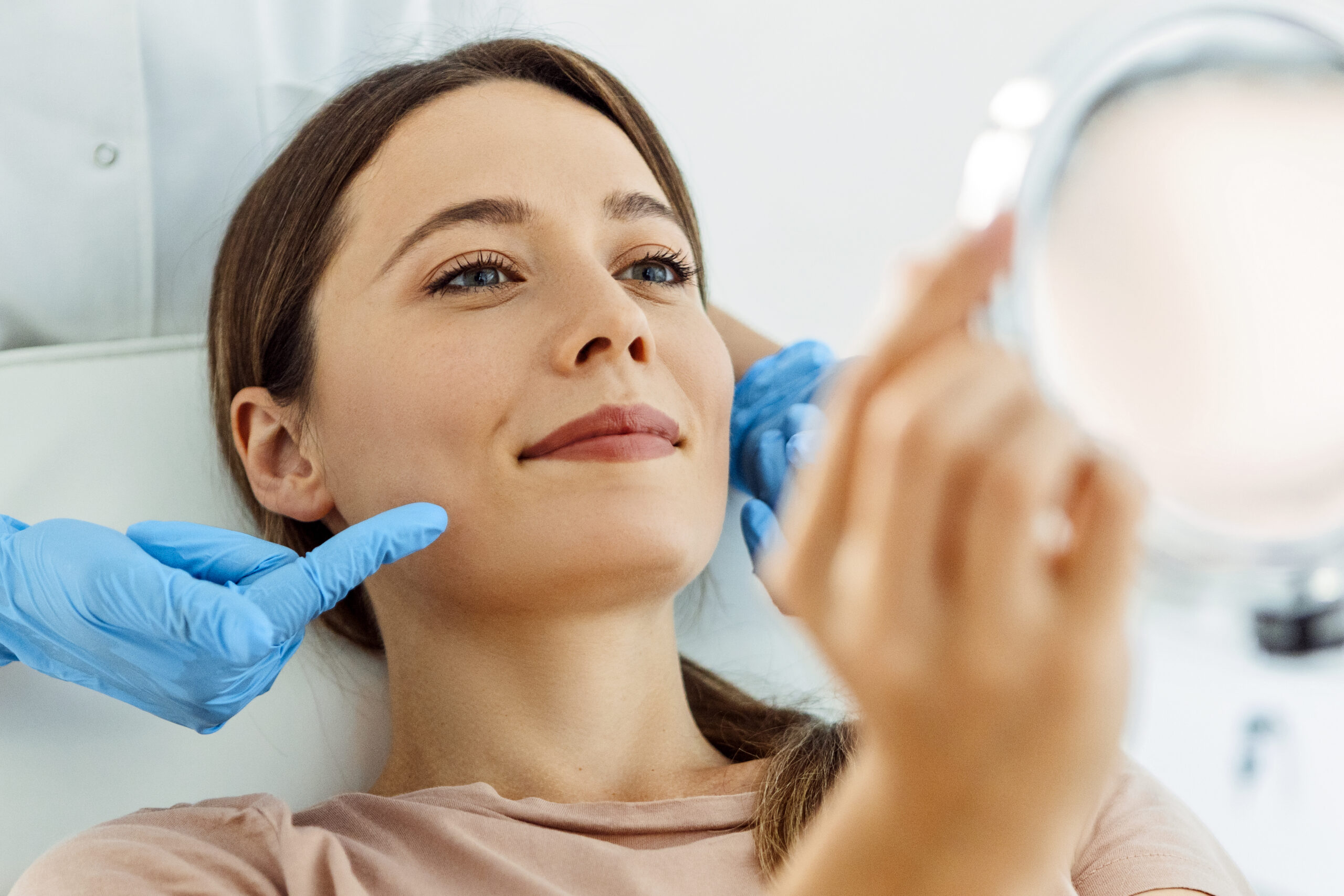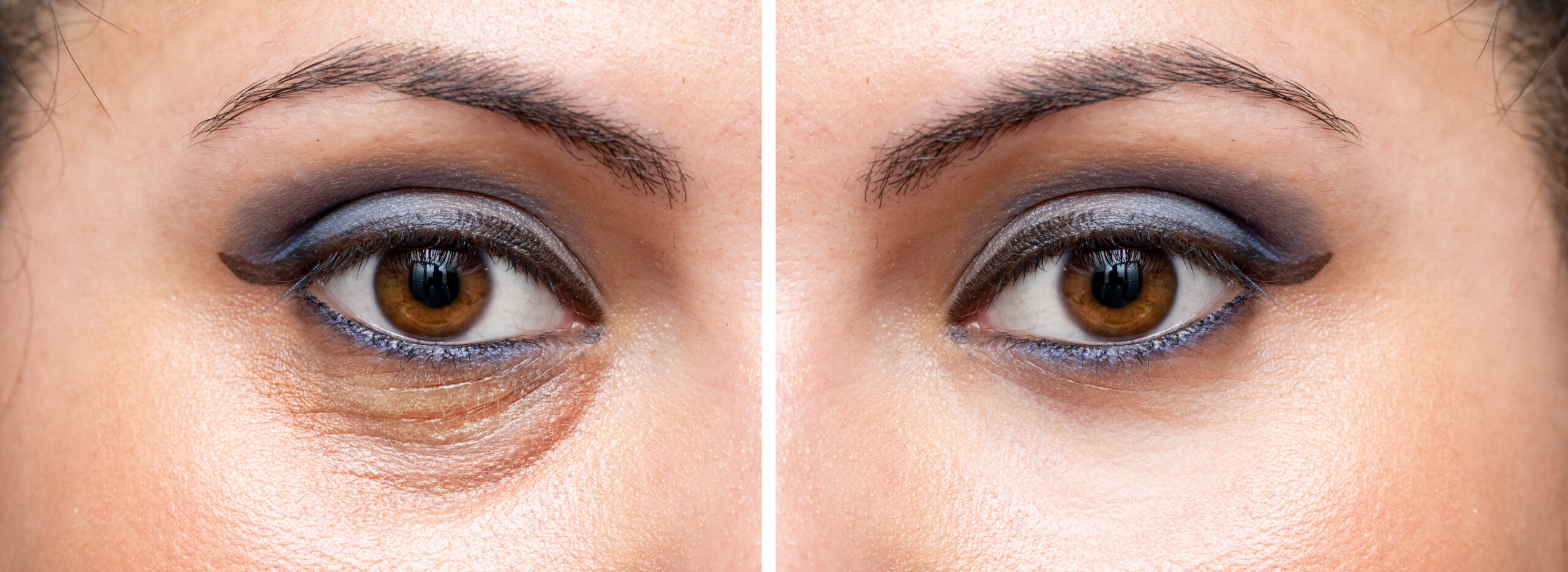What is Blepharoplasty (Eyelid Surgery)?
Blepharoplasty is a surgical procedure that reduces bagginess from lower eyelids and also helps to improve hooding of the upper eyelids. Blepharoplasty often calls for the removal of excess skin, muscle, and underlying fatty tissue and sometimes surgeons are able to reposition tissues can rather than remove them. While it is a cosmetic procedure, blepharoplasty is also an effective method for improving sight so patients whose sagging upper eyelids obstruct their vision benefit from this procedure.
Surgeons can perform Blepharoplasty in conjunction with other facial surgery procedures including laser resurfacing or brow lifts.
Who is a Good Candidate for Blepharoplasty?
As skin ages, it gradually loses its elasticity. A lack of elasticity, combined with the pull from gravity, causes excessive skin to collect in the upper and lower eyelids which causes wrinkles and bulges. On the upper eyelids, an extra fold of skin forms that can hang over the eyelashes and obstruct vision. These bulges on the upper and lower eyelids results from the fat that cushions the eyeball from the eye socket. The thin membrane that holds the fat in place weakens with age, allowing the fat to protrude into the lids.
The best candidates for blepharoplasty are individuals generally 30 years old or older who are in good health and who have no other eye conditions. Tell your doctor if you have any of the following conditions:
- Eye disease, such as glaucoma, dry eye, or a detached retina
- Thyroid disorders, such as Graves’ disease and under or overactive thyroid
- Cardiovascular disease, high blood pressure, or other circulatory disorders
- Diabetes
It is important for you to be realistic about the expectations you have for blepharoplasty. Eyelid surgery can enhance your appearance and help build your confidence but you should not expect the surgery to drastically change your look. Many people have eyes that are not aligned or that appear to be different sizes. Asymmetrical features occur during the early stages of development and blepharoplasty will not alter your facial structure. It is important to know your face well before you decide to have surgery. Think about your expectations and discuss them with your surgeon.

The Blepharoplasty Procedure
Surgeons perform Blepharoplasty in an outpatient setting and requires local anesthesia and sedation. The procedure can take anywhere from 30 to 60 minutes but the surgery length depends on whether you are having both the upper and lower eyelids done.
If your upper eyelids are being operated on, the incision lines are made along the natural crease lines of your eyelids. Once your surgeon makes the incisions, they remove fat deposits and excess skin. They may also remove a strip of the orbicularis oculi muscle that surrounds the eyelids and this will help them to deepen the lid crease if necessary.
If you have surgery for the lower eyelids, surgeons will make an incision either below the lower lash line or on the inside of the lower eyelid. Depending on the method, excess skin in the lower eyelid is removed or fat is redistributed or removed.
After the procedure, your surgeon will close your incisions with either removable sutures, skin adhesives, or surgical tape.
Blepharoplasty Surgery Before & After Photos
See before and after Blepharoplasty photos of people who trusted our doctors at SightMD for their treatment. Contact us to learn more about how Blepharoplasty can help you regain your confidence!
View Blepharoplasty Before & After PhotosRecovery & Aftercare For The Blepharoplasty Procedure
There are three primary side effects that are the focal points of blepharoplasty recovery. These include bruising, swelling, and scar maturation. Bruising can last two to three weeks. Swelling can take up to eight weeks to fully resolve. That said, both of these side effects improve significantly through the first week to 10 days after surgery. You can expect to look and feel well enough to return to work around 10 days post-op. While scarring improves enough to return to work and normal activities within weeks of surgery, this aspect of recovery can take a full year to reach its peak. Blepharoplasty scars are short and hidden. At first, they may appear pink and slightly raised or puffy. With time and the natural collagen remodeling that occurs around tissue wounds, scars lighten and flatten to a point at which they are no longer noticeable.
To recover well after blepharoplasty, it is important that you carefully follow your doctor’s aftercare instructions. General tips for blepharoplasty recovery include:
- Arrange sufficient time off work and other activities. Don’t plan to engage in any projects while off work.
- Make healthy meals ahead of time. This will minimize the amount of activity required of you as you heal.
- Care for your eyes following your post-op instructions such as applying ice packs a few times a day for the first few days of healing.
- Avoid smoking, tobacco products, and alcohol. These substances can inhibit healing and increase the risk of excessive bruising.
- Sleep with your head elevated so fluid can drain from the surgical site more efficiently.
- Protect your eyes from unnecessary irritation. Avoid eye strain by limiting screen time and reading. Avoid irritation by wearing sunglasses if you go outside.
- Avoid strenuous activity but spend some time walking every day to reduce the risk of blood clots forming due to inactivity.
Will I Have Any Scars After My Eyelid Surgery?
Blepharoplasty procedures require very small incisions to achieve excellent results. Depending on the procedure you choose, upper or lower blepharoplasty, your incisions may be completely hidden. Upper blepharoplasty incisions are usually made in the eyes’ natural crease. Here, the tiny scars that result from the incisions are hidden when the eyes are open. When your eyes are closed, upper blepharoplasty scars should look so discreet that, even up close, they blend in well with the surrounding skin. Lower blepharoplasty scars, as well, are out of view, situated just inside the lower eyelid in most cases.
How Soon After My Eyelid Surgery Procedure Will I See the Results?
You can expect to see a difference in the appearance of your eyes right after surgery. That said, results will be obscured to some degree due to swelling and bruising. As tissues recover and inflammation subsides, the rejuvenated appearance of your eyelids becomes more pronounced. We typically advise patients not to assess their results until they have reached the six-week mark after their procedure. At that point, swelling should be nearly gone.
Will the Results of My Blepharoplasty Be Permanent?
The results of upper or lower blepharoplasty are expected to last many years. Over time, as the skin continues to age, the eyelids may lose some degree of their youthful shape. To prolong the effects of blepharoplasty as long as possible, we suggest wearing sunglasses and broad-spectrum sunscreen every day. When you plan to be outdoors for more than a few minutes, elevate your sun protection by wearing a wide-brimmed hat. Good skin care practices and periodic cosmetic treatments may also help sustain a more youthful appearance.
Will My Eyelid Surgery Results Look Natural?
Yes. Your doctor performs eyelid rejuvenation surgery with careful consideration for your natural eye shape and brow position. Tissue is trimmed in such a way to accentuate the natural curvature of the upper eyelid or lower eyelid while simultaneously preserving the ability to close your eyes completely once you have recovered from the procedure.
Contact SightMD today to schedule an appointment with one of our doctors to discuss your Ophthalmic Plastic Surgery options at one of our convenient locations!

The Medical Benefits of Botox that Most Might Not Know About
When most people think of Botox, they envision its use as a cosmetic treatment to reduce the appearance of…

The Benefits of Oculoplastic Surgery for Aging Eyes
As we age, our eyes and the surrounding areas often show the earliest signs of aging. Droopy eyelids, bags…

Exploring the Dual Purpose of Oculoplastic Surgery
Understanding Oculoplastic Surgery for Cosmetic and Medical Applications Oculoplastic surgery, often associated with cosmetic enhancements, encompasses a wide range…